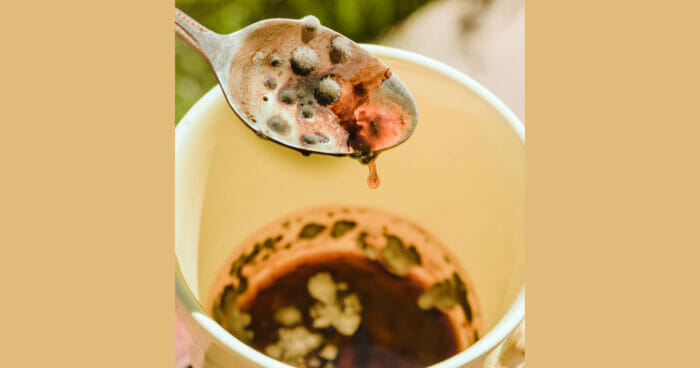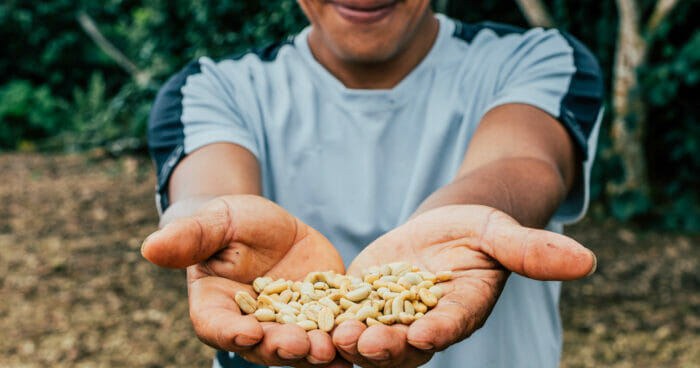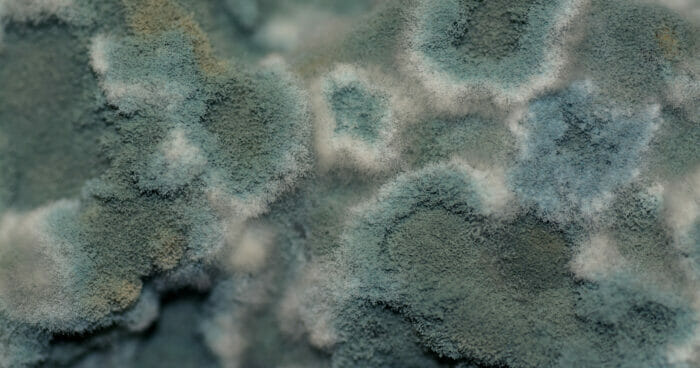We normally judge the quality of a coffee by its aroma, flavor, and body taste – but never by its mycotoxin level. The problem is that mold in coffee can occur. This happens on some coffee beans due to climate and growth conditions, also if the beans are not stored properly. The result can be fungi producing a harmful substance called mycotoxins.
The bigger problem most people are concerned about is that regularly consuming mycotoxins in their daily cup of coffee could be detrimental to their overall health.
Possible health effects associated with fungi generally fall into the category infections (mycosis), allergic reactions, or toxic effects.
Kraft, 2021
However, is there enough mold in most types of coffees to pose any serious threat to our health?
In this article, we’ll explore various questions we had about the issue of finding mold in coffee including:
- What causes mold to grow in coffee?
- What are the common types of mold growth found in coffee?
- What are the potential concerns associated with mycotoxins in coffee?
- How to avoid exposure to coffee beans that are contaminated by mold
What Happens If You Drink Moldy Coffee?
If you’ve drunk coffee with detectable levels of mold in it, you’ll likely start to feel the effects of it within a few hours after consumption.
The effects you might experience from drinking moldy coffee could include:
- Feeling irritable
- Feeling anxious
- Feeling dizzy
- Getting an upset stomach
- Getting a headache
If you are regularly consuming moldy coffee then you may experience other health effects that are linked to having a mold allergy like itchy skin, a skin rash or other symptoms.
Does Mold Grow In Coffee?
Yes, mold can grow in coffee due to the way it is grown, processed or stored.
Why Is There Mold in Coffee?
If mold grows on green coffee beans it will be due three reasons, which include the type of climate in which they are grown, the methods used to harvest the green coffee beans and then how they are stored.
1. How Coffee Beans Are Grown
On particularly humid days, green coffee beans absorb a significant amount of water from the air. If the humidity continues, there is a risk that mold can form.
2. How Coffee Beans Are Harvested
Mycotoxins can form pre and post-harvest of coffee beans on coffee farms. They can also form before and after the product has been packaged. Mold can also form through improper handling. Once farmed, green coffee beans go through wet processing. Sometimes, farmers fail to dry these coffee beans properly. The machinery used could also be old and moldy.
3. How Coffee Beans Are Stored
Green coffee beans can be stored in warehouses for a prolonged period without humidity control and this type of storage and the shipping time before the beans get to a coffee roaster can put the beans at risk of the formation of a mold growth.
What Types of Mycotoxins Are Found in Coffee?
The two common mycotoxins that can be found in coffee beans are, Ochratoxin A and Aflatoxin B1.
1. Ochratoxin A
Ochratoxin A (OTA) is the most common mycotoxin that might be found on coffee beans.
Even after the roasting process (which does help reduce mycotoxin presence somewhat), signs of Ochratoxin A can still be found in over a third of coffee beans.
2. Aflatoxin B1
Aflatoxin B1 is one of the most toxic mycotoxins around. The range of possible side-effects from aflatoxin exposure vary a lot depending if there has been an acute exposure or chronic exposure.
How Do You Know if Coffee Is Mold Free?
You most likely won’t be able to detect small amounts of mycotoxins yourself just by smell, taste or looking at the coffee beans.
However, you might know if you have a mold allergy making you more sensitive to mold exposure and will experience side-effects when drinking certain types of coffee.
The best way to know for certain if a coffee does or does not have any mold contamination is to have it tested by a thrid party laboratory. This is something we would need to rely on the coffee supplier doing for us.
There are several coffee brands available in the US, Canada, UK, Europe and Australia that specially test their coffee for mold levels. We have a list of who are these mold-free coffee brands for you.
Purity Coffee has a great selection of mycotoxin tested organic coffee beans that are all speciality coffee rated for a coffee shop level taste experience.
How To Avoid Coffee With Mold
Here are ways to help you try to avoid drinking moldy coffee:
1. Buy Premium Coffee Beans
Premium coffee beans need to pass speciality coffee tasting standards so go through more care from growing to harvesting and storage.
Ever since I started drinking my first cup of Bulletproof Coffee, I have read from multiple coffee roasters that supply mold-free coffee beans to look to buy coffee that has been grown at higher altitudes, is organic, pesticide-free and is wet processed.
2. Store Your Coffee Properly
Ground coffee should be stored in a cool, dry place away from heat and moisture when not in use.
You should also keep your coffee in an air-tight container to avoid it being exposed to humidity in the kitchen causing it to spoil and degrade in taste as well. This air-tight container should also feature opaque sides to stop direct sunlight degrading the coffee beans or ground coffee.
4. Keep Your Coffee Making Equipment Clean
After you’ve had your morning cup of coffee, give your coffee maker and equipment a good clean and dry.
This includes cleaning any kitchen counter single-coffee makers, drip coffee machines, coffee grinders, moka pots and other stove coffee makers, aeropress metal filters etc… Harmful mold toxins could form through cleaning negligence.
5. Taste Test Your Coffee
If your coffee tastes bad then just don’t drink it to lower your risk of any exposure, also don’t drink bad tasting coffee it is not worth the caffeine lift.
What Are Mycotoxins?
Mycotoxins are a toxic substance that is naturally produced by certain fungi (a.k.a molds).
A more specific definition is:
Mycotoxins are secondary metabolites produced by microfungi that are capable of causing disease and death in humans and other animals.
Bennett, 2003
How Common Are Mycotoxins in Our Food?
Mycotoxins appear to be relatively common in food grown for human and animal consumption, with main source being cereals.
The Food and Agriculture Organization (FAO) estimated global food crop contamination with mycotoxins to be 25%
Eskola, 2019
The good news is that there are stringent legal food standards in place to make sure common types of pant-based foods are tested for any detectable mycotoxin levels before it is processed and sold to us at supermarkets.
The EU set new maximum acceptable levels in 2022 as an example, and the FDA have standards for the US.
What Other Common Foods Can Contain Mycotoxins?
Mycotoxins are not only found in coffee beans, but they can also be found in other plant based foods. This includes foods that originate from places with hot and humid climates.
A list of foodstuffs that might commonly contain a mycotoxin presence include:
- Nuts
- Rice
- Cereals
- Spices
- Dried fruits
There are hundreds of individually classed mycotoxins that can form in food. Only a select few, however, pose a threat to our health.
What Other Ways Are We Exposed to Mycotoxins?
We are all constantly exposed to mycotoxins from a variety of sources in our activities of daily living and living conditions.
Common sources of mycotoxin exposure can be via:
- Oral exposure (dietary)
- Inhalation (breathing)
- Dermal contact (skin contact)
Where Else Do You Find Mycotoxins in a Home?
Food isn’t the only way we’re regularly exposed to mycotoxins; we can be exposed to mycotoxins inside our buildings.
For example, if you’ve got a leak, dampness may form on your wall. Mold will form if you leave the damp spots for long enough. The mold spores that form release mycotoxins into the air, thus creating a health risk.
What Effect Can Mycotoxins Have On Our Health?
Being exposed to mycotoxins can cause mycotoxicosis. Mycotoxicosis is a term for diseases linked to mycotoxin exposure via ingesting them, inhaling them or having skin contact with them.
Acute mycotoxicosis symptoms can include:
- GI Tract disturbances
- Vomiting
- Abdominal pain
- Trouble breathing
Symptoms experienced will be affected by many factors including:
- Which type of mycotoxin a person is exposed to
- The duration of the exposure
- The amount of exposure
- The age of the person
- Any other conditions the person already has
A 2022 systematic review did not see strong evidence that mycotoxin exposure poses a significant cancer risk.
There is the ICD-10 code T64 used on medical billing for patients suffering the toxic effects of mycotoxin food contaminants.
FAQs
Is moldy coffee bad for you?
Yes, consuming mold that produces mycotoxins is not beneficial for your health and some molds can be dangerous. If your coffee is moldy then do not drink it.
Can you buy beans that are free from coffee mold?
Yes, you can buy coffee beans from select brands that have been third party tested by a laboratory to confirm that they contain no mycotoxin levels.
How do you remove mold from your coffee maker?
You can easily remove mold from your coffee maker by thoroughly cleaning it with a mix of water and vinegar. You should regularly check your coffee equipment for signs of mold to avoid the health risks of drinking coffee containing traces of mold.
Final Thoughts
If you drink lots of different types of coffee regularly, you’ll likely have consumed a cup of coffee with some level of mold in it. While Ochratoxin A and Aflatoxin B1 can be dangerous, the small amount found in coffee beans is unlikely to impact your health.
You are able to purchase coffee beans that have been tested to be mold free in order to know confidently that there is no mold in your coffee.
Sources
- https://www.ncbi.nlm.nih.gov/pmc/articles/PMC8619365/
- https://www.ncbi.nlm.nih.gov/pmc/articles/PMC164220/
- https://www.eurofins.co.uk/food-testing/contaminants-and-residues/mycotoxins/
- https://doi.org/10.1080/10408398.2019.1658570
- https://www.food-safety.com/articles/8065-new-eu-maximum-levels-for-mycotoxin-ochratoxin-a
- https://www.fda.gov/food/natural-toxins-food/mycotoxins
- https://www.frontiersin.org/articles/10.3389/fcimb.2018.00060/full
- https://www.ncbi.nlm.nih.gov/pmc/articles/PMC9266006/
- https://icd.who.int/browse10/2019/en#/T64
- https://pubmed.ncbi.nlm.nih.gov/24152987/
- https://www.ncbi.nlm.nih.gov/books/NBK557781/
- https://my.clevelandclinic.org/health/diseases/22309-mold-allergy
- https://www.who.int/news-room/fact-sheets/detail/mycotoxins






